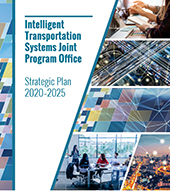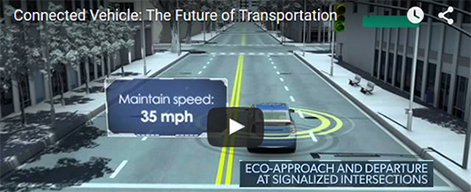News & Information
AERIS (Applications for the Environment: Real-Time Information Synthesis) ConOps and Modeling Workshop
When: March 26-27, 2013
Time: March 26: 9:00 A.M. to 5:00 P.M. Eastern Time
March 27: 9:00 A.M. to 4:30 P.M. Eastern Time
Where: Washington, D.C.
The U.S. Department of Transportation (U.S. DOT) will host a free public workshop to discuss the AERIS (Applications for the Environment: Real-Time Information Synthesis) Program and solicit public input for its Transformative Concepts. The AERIS Program recently developed Concepts of Operations (ConOps) and Analysis Plans for modeling three Transformative Concepts: Eco-Signal Operations, Dynamic Low Emissions Zones, and Dynamic Eco-Lanes. The purpose of the workshop is to solicit input from stakeholders on these draft documents. Emphasis will be placed on how traffic simulation (e.g., Paramics, VISSIM) and environmental models (e.g., MOVES) will be used to evaluate connected vehicle applications focused on reducing transportation’s impact on the environment.
The meeting is being organized by the Intelligent Transportation Systems Joint Program Office (ITS JPO) which is part of the Research and Innovative Technology Administration (RITA). A webcast will be offered for portions of the workshop at no charge for those participants who are not able to attend the workshop in person. The webcast will provide participants an opportunity to contribute to discussions using electronic tools.
About the AERIS Program:
Connected vehicle research is a multimodal initiative that aims to enable safe, interoperable, and networked wireless communications among vehicles, infrastructure, and passengers’ personal communications devices. This research leverages the potentially transformative capabilities of wireless technology to make surface transportation safer, smarter, and greener. The objective of the AERIS research program is to generate and acquire environmentally-relevant real-time transportation and environmental data, and use these data to create actionable information that supports and facilitates “green” transportation choices by transportation system users and operators. Employing a multi-modal approach, the AERIS Program is working in partnership with the vehicle-to-vehicle (V2V) and vehicle-to-infrastructure (V2I) communications research efforts to better define how connected vehicle data and applications might contribute to mitigating some of the negative environmental impacts of surface transportation.
About the AERIS ConOps and Modeling Workshop:
The purpose of this workshop is to obtain stakeholder input on draft ConOps and Analysis Plans for three of the AERIS Program’s Transformative Concepts. Transformative Concepts are integrated operational concepts that use V2V, V2I, and other data and communications in innovative ways to operate surface transportation networks in an effort to reduce transportation-related emissions and fuel consumption. Transformative Concepts are intended to change the way surface transportation systems operate, with an emphasis on combining connected vehicle applications to provide significant environmental benefits. Transformative Concepts discussed during the workshop include:
- Eco-Signal Operations – This Transformative Concept investigates applications that use connected vehicle technologies to decrease fuel consumption and decrease greenhouse gas (GHG) and criteria air pollutant emissions by reducing idling, the number of stops, unnecessary accelerations and decelerations as well as improving traffic flow at signalized intersections.
- Dynamic Eco-Lanes – This Transformative Concept features dedicated lanes optimized for the environment, referred to as eco-lanes. Eco-lanes are similar to high-occupancy vehicle (HOV) lanes and are optimized for the environment through the use of connected vehicle data. These lanes are targeted toward low-emission, high-occupancy, freight, transit, and alternative-fuel vehicles (AFV). Drivers are able to opt in to these dedicated eco-lanes to take advantage of eco-friendly applications such as eco-cooperative adaptive cruise control (CACC) and connected eco-driving applications. At the heart of this Transformative Concept are applications that support the operation of dynamic eco-lanes, including establishing criteria for entering the lanes and defining or geo-fencing the eco-lane boundaries, allowing the lanes to be dynamic.
- Dynamic Low Emissions Zones – This Transformative Concept investigates geographically defined areas that seek to restrict or deter access by specific categories of high-polluting vehicles to improve the air quality within the geographic area. The low emissions zone can be dynamic, allowing the operating entity to change the location, boundaries, fee or incentive structure, or the time the low emissions zone will be established and its duration. At the heart of this Transformative Concept is an application that leverages connected vehicle technologies to dynamically determine fees or provide incentives for “green” vehicles entering the low-emissions zone. Fees or incentives may be based on the vehicle’s engine emissions standard or emissions data collected directly from the vehicle using V2I communications.
Draft ConOps and Analysis Plans were developed for each Transformative Concept and will be discussed during the workshop. The ConOps are intended to serve as blueprints describing the Transformative Concepts so stakeholders can understand how they may work. These documents include user needs – or desired capabilities – of the proposed systems and operational scenarios for the connected vehicle applications. Analysis Plans provide details of the modeling approach that will be used by the AERIS Program to evaluate the Transformative Concepts and includes:
- Hypotheses used to test the expected impact of the Transformative Concepts;
- Performance measures used for evaluating the Transformative Concepts;
- Description of the network (e.g., signalized arterial, freeway, multi-modal corridor, transit system, freight network, regional network) that will be used to model the Transformative Concepts; and
- The modeling approach and selected modeling and analysis tools.
During this workshop, the AERIS team will facilitate interactive break-out sessions to obtain stakeholder input on desired capabilities and the Analysis Plan for evaluating environmental benefits of three AERIS Transformative Concepts. Break-out sessions will also include discussion on the role of automation, transit, freight, and AFVs. This valuable feedback will be utilized by the U.S. DOT to further define the Transformative Concepts. Input from this workshop will enable the U.S. DOT to conduct future research and modeling activities focused on the potential environmental benefits that can be achieved in a connected vehicle environment. For more information on the AERIS Program and the Transformative Concepts, visit: http://www.its.dot.gov/research_archives/aeris/index.htm
Event Location
Hyatt Regency Washington
On Capitol Hill
400 New Jersey Ave NW
Washington, DC 20001
(202) 737-1234










